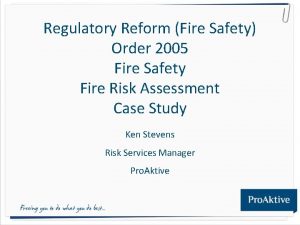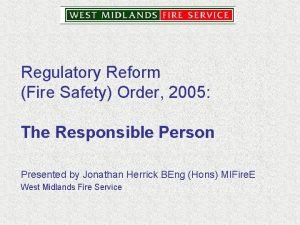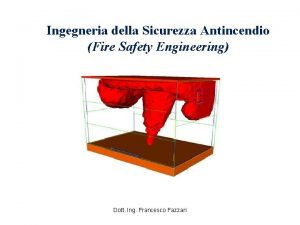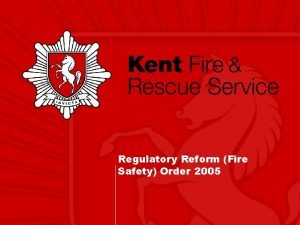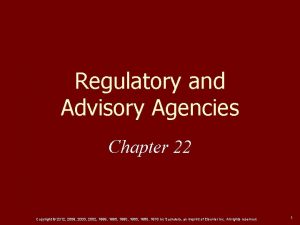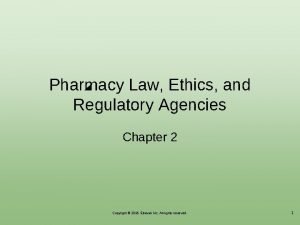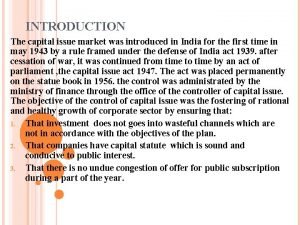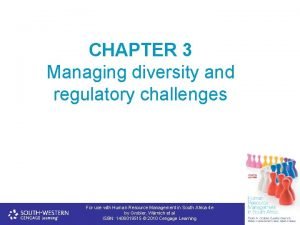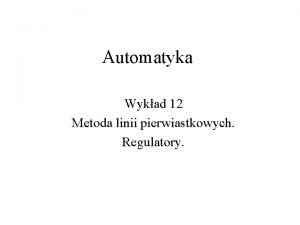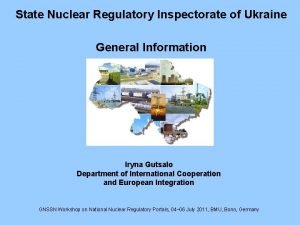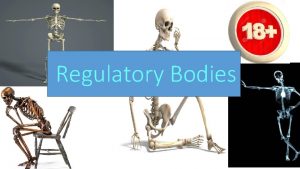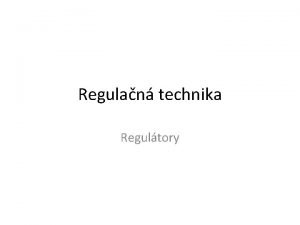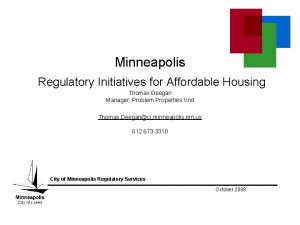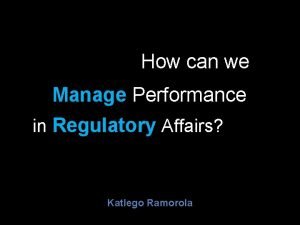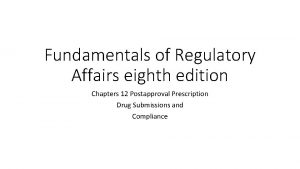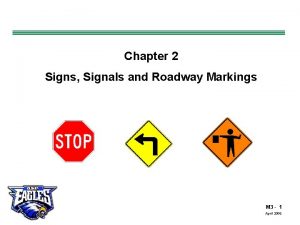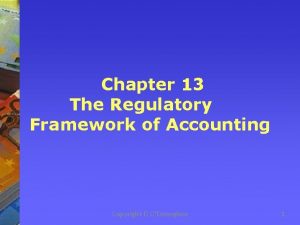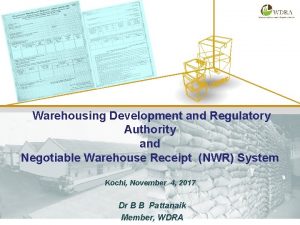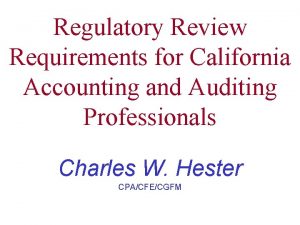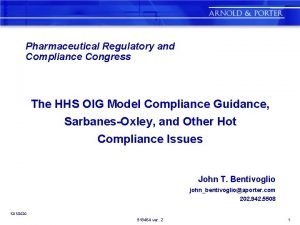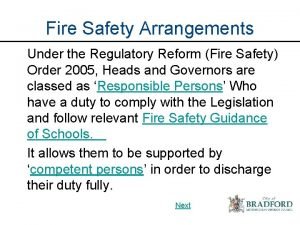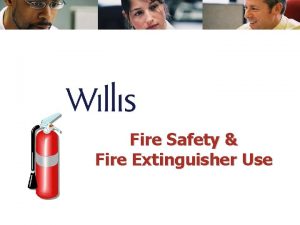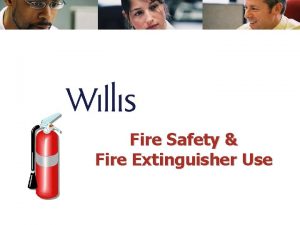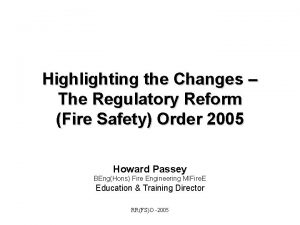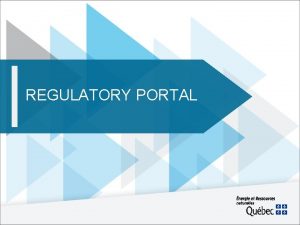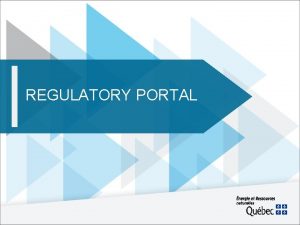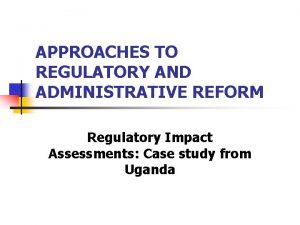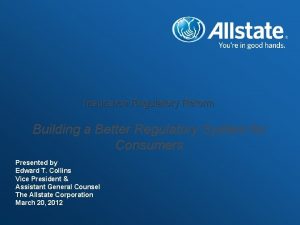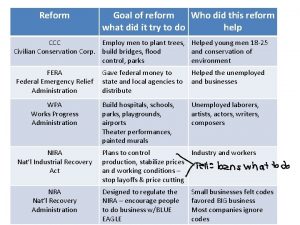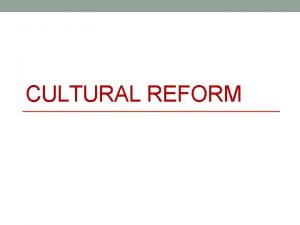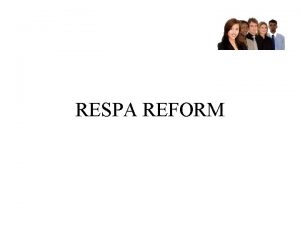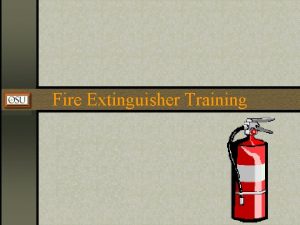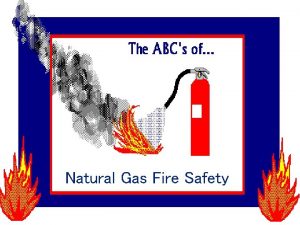Regulatory Reform Fire Safety Order 2005 Fire Safety







































- Slides: 39

Regulatory Reform (Fire Safety) Order 2005 Fire Safety Fire Risk Assessment Case Study Ken Stevens Risk Services Manager Pro. Aktive

Who enforces the Order? • Local Authority Fire and Rescue Service • Penalties – failing to comply may result in a fine or a term of imprisonment not exceeding two years

Who is the responsible person? • Employer with control of a workplace • Person with overall management of a building • Occupier of premises, Owner of premises (i. e. empty buildings) • Landlords (multi occupied buildings)

What are the implications for businesses? • Businesses regardless of size will have to conduct a comprehensive fire risk assessment to identify: – The elimination or reduction of risks – Suitable means of detecting & raising the alarm in the event of fire – Adequate emergency escape routes & exits including emergency lighting – The appropriate type & sufficient quantities of fire extinguishers – Correct type & sufficient quantities of fire signs & notices – Provisions for the correct maintenance of installed fire equipment

What are the implications for businesses? – Procedures for serious and imminent danger • Fire evacuation procedures • Nomination of fire wardens/marshals • Fire drills – Emergency measures where dangerous substances are used • • Information on emergency arrangements Suitable warning/communication systems Visual/audible warning systems – explosion Escape facilities –indicated on risk assessment

What are the implications for businesses? – Ensure that employees, nominated persons, visitors and contractors receive the appropriate instruction / training in, e. g. actions to be taken in the event of fire and fire evacuation drills

General Fire Precautions • • • Reduce the risk and spread of fire Ensure means of escape at all times Fire fighting measures on premises Fire detection and warnings of Action in the case of fire – Training and instruction – Measures to mitigate the effects

Fire safety risk assessment 1. Identify the fire hazards 2. Identify the people at risk 3. Evaluate, remove or reduce, and protect from risk 4. Record, plan, inform, instruct, and train 5. Review

1. Identify the fire hazards Fuel Ignition Source Oxygen

Sources of ignition ARSON Electrical Smokers materials Naked flames Contractors Portable heating equipment • Hot processes- paint stripping, welding • Lighting equipment • • •

Sources of fuel • Flammable liquid based products • Process Materials • Packaging materials • Waste products • Soft furnishings and furniture • Some construction materials

Sources of Oxygen • • The air around us Air conditioning Some chemicals Oxygen supplies – cylinder storage

2. Identify the people at risk • Employees especially those who work alone • Vulnerable people • Contractors • Young people • Other people in the immediate vicinity • Fire fighters

3. Evaluate, remove, reduce, and protect from risk Evaluate the risk of a fire occurring: – Accidentally – By act or omission – Deliberately

3. Evaluate, remove, reduce, and protect from risk Evaluate the risk to people Fire is spread by: – Convection – Conduction – Radiation – Contact or direct heat

Smoke movement through a building

Why we close fire doors

Evaluating the risks to people Consider: • Fires on lower floors can affect escape routes for those on upper floors • Fires developing in unoccupied spaces which people have to pass • Spread of fire or smoke via vertical shafts and service or ventilation ducts • Fires in service rooms affecting hazardous materials

Remove or reduce the hazards - sources of ignition • • • Replace potential sources of ignition with an alternative Replace naked flame and radiant heaters with fixed convector heaters or central heating Separate ignition sources and fuels Check areas after hot work has taken place Take precautions to avoid arson

Remove or reduce the hazards - sources of fuel • Ensure flammable materials, liquids and gases are kept to a minimum and stored properly • Do not keep flammable solids, liquids and gases together • Remove combustible waste daily • Store waste materials securely away from buildings.

Remove or reduce the hazards – sources of oxygen • Close all doors, windows and other openings when not required for ventilation • Shut down inessential ventilation systems • Do not store oxidising materials next to heat sources or flammable materials • Control use of oxygen cylinders

Remove or reduce the hazards – to people • Ensure that any risks remaining to people are controlled • Provide systems to warn people and allow them to escape in the event of fire • Provide adequate exits for the number of people present

Fire detection and warning systems • System will depend on the size and layout of the building • It should provide adequate warning in the event of a fire • Automatic or manual? • You may/will need special arrangements for people with disabilities

Fire-fighting equipment and facilities • Can reduce the risk of a small fire (waste paper bin) developing into a larger one • Controlling a fire in the early stages can reduce the risk to people • There should be enough portable extinguishers suitable for the risk • They should be sited throughout the premises at suitable locations

Fire-fighting equipment and facilities Co 2 Foam Powder Water

Fire-fighting equipment and facilities • Class A fire – rule of thumb one water extinguisher for every 200 m² minimum 2 per floor • Additional risks – appropriate type & number of extinguishers. See BS 5306 -8

Other facilities Can include: • Access for fire engines and fire-fighters • Fire-fighting shafts and lifts • Fire suppression systems – sprinklers • Smoke-control systems • Dry or wet rising mains and fire-fighters inlets • Information and communication systems • Fire-fighters switches

Escape routes should be: • Suitable • Easily, safely and immediately usable at all times • Adequate for the number of people • Free from any obstructions, slip or trips hazards • Available for access by the emergency services

Escape routes Suitable: – Fire resistant construction – Escape routes should not go through other occupiers premises – Doors should open in the direction of travel – Be fitted with vision panels if over 60 people

Emergency escape lighting Provided on all escape routes to assist in evacuation and should cover: • Exit doors and escape routes • Intersections of corridors • Outside each final exit and external escape routes and stairways • Changes in level • Fire equipment and alarm call points

Signs and notices • Comply with British or European standards • Not mixed • Be fire resistant British Standard European Standard

Installation, testing & maintenance • Installed by competent persons • Maintained in line with manufacturers guidance • Tested weekly • Inspected quarterly • Records kept for inspection

4. Record, plan, inform, instruct & train • Fire risk assessment – recorded available for inspection • Actions prioritised and implemented • Evacuation plans developed, implemented and tested – at least twice annually • Employee groups informed of results • Employees, visitors, contractors given adequate training and instruction

5. Review risk assessments, plans etc: • When changes occur – changes to work processes, alterations to the building or work patterns • Introduction of new equipment, hazardous substances, significant increase in people • At least annually

Woolworths Manchester 1979 11 Dead Alarm not sounded Fire Brigade not called Fire Escapes Locked

Fire at Bradford 11 th May 1985 • Time : first flame - well alight? • How many died? • Why? • 2 -3 Minutes • 56 people lost their lives • Very Poor standards of Fire Safety

Recent Case • Conveyor Fire in a bagging plant • Hot product left on conveyor

Cost Of Claim – Emergency works – Contract Sum – Professional Fees – Machinery, Plant & AOC – Business Interruption Total £ 7, 441. 87 £ 85, 668. 64 £ 9, 411. 61 £ 33, 989. 62 £ 8, 039. 10 £ 144, 550. 84

Programme
 Regulatory reform fire safety order 2005
Regulatory reform fire safety order 2005 Regulatory reform fire safety order 2005 summary
Regulatory reform fire safety order 2005 summary Ingegneria sicurezza antincendio
Ingegneria sicurezza antincendio Regulatory reform (fire safety) order 2005 article 8 to 23
Regulatory reform (fire safety) order 2005 article 8 to 23 Fire hose reel signage standards
Fire hose reel signage standards Via optica
Via optica Btec sport unit 3
Btec sport unit 3 Dispositional framework vs regulatory framework
Dispositional framework vs regulatory framework Signs have three purposes, identify the three.
Signs have three purposes, identify the three. Regulatory framework of financial services in india pdf
Regulatory framework of financial services in india pdf Chapter 22 regulatory and advisory agencies
Chapter 22 regulatory and advisory agencies Dea number verification
Dea number verification Milady infection control
Milady infection control Regulatory functions of sebi
Regulatory functions of sebi Functions of financial system
Functions of financial system Regulatory change management process
Regulatory change management process Irda objectives
Irda objectives Diversity and regulatory challenges
Diversity and regulatory challenges Regulatory signs color
Regulatory signs color Regulatory capital vs economic capital
Regulatory capital vs economic capital Regulatory capital vs economic capital
Regulatory capital vs economic capital Metoda linii pierwiastkowych
Metoda linii pierwiastkowych Gene regulatory network
Gene regulatory network State nuclear regulatory inspectorate
State nuclear regulatory inspectorate Diamond shaped yellow sign with black markings
Diamond shaped yellow sign with black markings Gene regulatory network
Gene regulatory network Film regulatory bodies
Film regulatory bodies Nespojité regulátory
Nespojité regulátory Minneapolis regulatory services
Minneapolis regulatory services Kpi regulatory affairs
Kpi regulatory affairs Post approval regulatory affairs
Post approval regulatory affairs Biologycorner.com
Biologycorner.com Fluorescent optic yellow sign
Fluorescent optic yellow sign Contoh kebijakan regulatif
Contoh kebijakan regulatif Regulatory framework accounting
Regulatory framework accounting Warehouse regulatory and development authority
Warehouse regulatory and development authority Regulatory creep
Regulatory creep California cpa regulatory review
California cpa regulatory review Oig pharma compliance guidance
Oig pharma compliance guidance National institute for food and drug surveillance
National institute for food and drug surveillance
